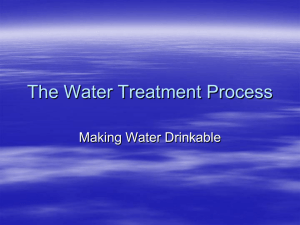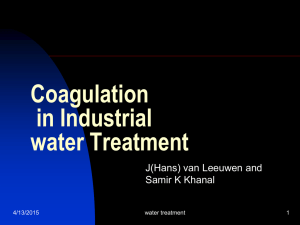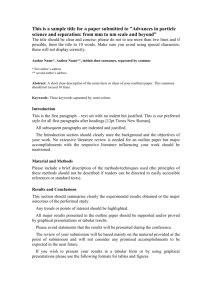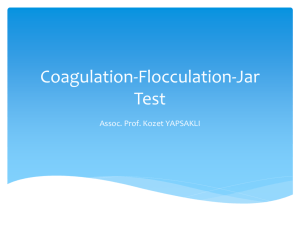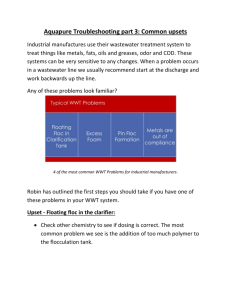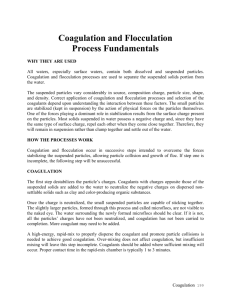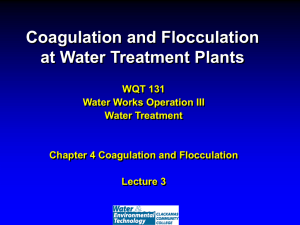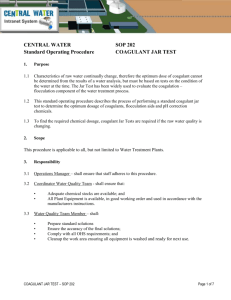JAR TESTING: CONSIDERATIONS AND PROCEDURE
advertisement
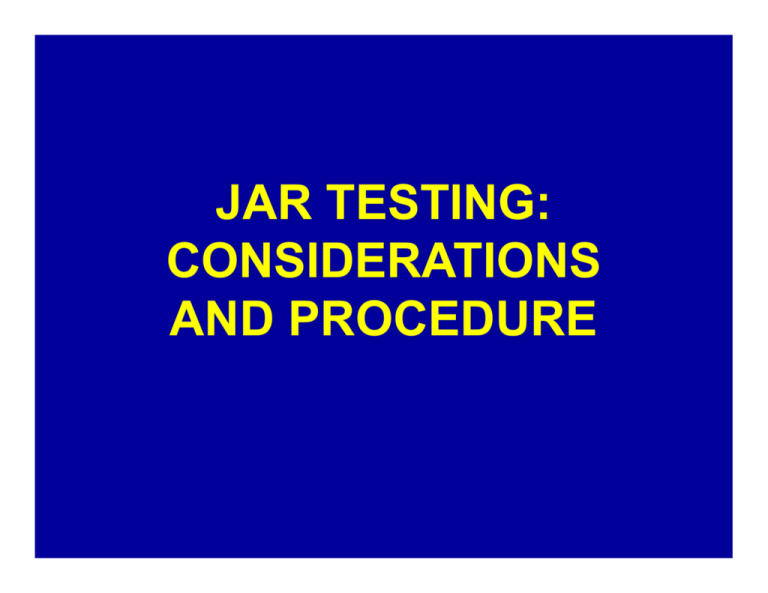
JAR TESTING: CONSIDERATIONS AND PROCEDURE Purpose of Coagulation and Flocculation Remove particulate impurities, especially non-settleable solids and color from the water being treated Non-Settleable solids include colloidal material that exhibits slightly negative charges repelling one another and staying in Suspension These contain microbes including pathogens Removal of Turbidity by Coagulation & Production of Floc Neutralization of repulsive charges Precipitation with sticky flocs Bridging of suspended matter Providing “agglomeration sites” for larger floc Weighting down of floc particles Factors Affecting the Coagulation Process pH (Al from 5 – 7; Fe from 5 – 8) Alkalinity of water (> 30 ppm residual) Concentration of Salts (affect efficiency) Turbidity (constituents and concentration) Type of Coagulant used (Al and Fe salts) Temperature (colder requires more mixing) Adequacy of mixing (dispersion of chemical) Primary Coagulants Primary coagulants are lime, aluminum sulfate (alum), ferrous sulfate, ferric sulfate and ferric chloride These inorganic salts will react with the alkalinity in the water to form insoluble flocs which will trap the suspended matter in them Use of Alum as a Coagulant Earliest and Most Widely Used Coagulant Effective Range pH 5.0 to 7.0 (6.5 optimal) Reacts with Alkalinity Results in drop in pH For every 2 mg/L Alum 1 mg/L Lime is Use of Ferrous Sulfate (Copperas) and Lime for Coagulation Combination produces Ferric Hydroxide pH 8.4 range to 9.0 Oxygen must added by aeration or chemically such as chlorine Very effective for turbid water Care must be taken because color not removed at high pH Use of Ferric Chloride as a Coagulant Has wider pH range than Ferrous Sulfate Typically used where color removal is also desirable Does not require oxygen supplement Use of Ferric Sulfate as a Coagulant Does not require oxygen supplement Effective over wider pH ranges Lower doses required that Ferrous Sulfate Secondary Coagulants or Coagulant Aids Coagulant aids are often added to help stimulate the production of floc They include sodium aluminate, sodium silicate and various synthetic organic water soluble polyelectrolytes or polymers Desirable Floc Quality The best floc are smooth circular particles that tend to settle quicker Irregular shaped particles settle slower Large clumps (popcorn floc) settle fast but are caused by chemical overdosing Performance Measurement Using the Jar Test A jar test is a laboratory procedure where varying dosages of coagulant are tested in a series of glass or plastic jars under identical conditions The jars are injected with coagulant dosages and mixed to match flash mix & flocculation field conditions as closely as possible After mixing and settling the jars are observed to determine which dosage produce the largest, strongest floc or which dosage produces the floc that settles the fastest Other laboratory tests sometimes include a jar test to determine the optimal pH or determine the turbidity of the Factors Affecting the Coagulation Process Revisited pH range: 5 – 7 Alkalinity of water > 30 PPM residual Concentration of Salts affects efficiency Turbidity (constituents and concentration) Type of Coagulant used (Al and Fe salts) Temperature (colder requires more mixing) Adequacy of mixing (dispersion of chemical) Jar Test Apparatus and Procedures Four or six paddles Typically, one container is used as control RPM gauge allows for mixing speeds to match plant conditions for flash mix and flocculation Can be programmable or manual Determining Mixing Scheme Graph Created by Camp, 2930s 500 400 300 G, s-1 200 100 Find energy from plant 80 60 Then determine mixing speed from graph 50 40 30 20 10 10 20 30 40 50 60 70 80 Speed, rpm 90 100 200 Evaluation of Jar Test Results Rate of Floc Formation Type of Floc Particles Clarity of the Water between the Floc Size of the Floc Amount of Floc Clarity of Water above Settled Floc Volume of Floc Jar Test Plot for Low Alkalinity Water Alum initially reacts with low alkalinity With Ferric Chloride requires chemical to reach optimal pH before reacting Adding too much l t Jar Test Plot for Higher Alkalinity Water Higher Coagulant doses are needed for high alkalinity waters Ferric Chloride required more chemical but reached lower turbidity Since Alum did not produce water <1 NTU a coagulant aid is Additional Analyses for Jar Testing TOC Alkalinity pH Turbidity of Supernatant Filtered Turbidity of Supernatant JAR TESTING PROCEDURE Purpose To determine the optimum concentration of coagulant to be added to the source water
